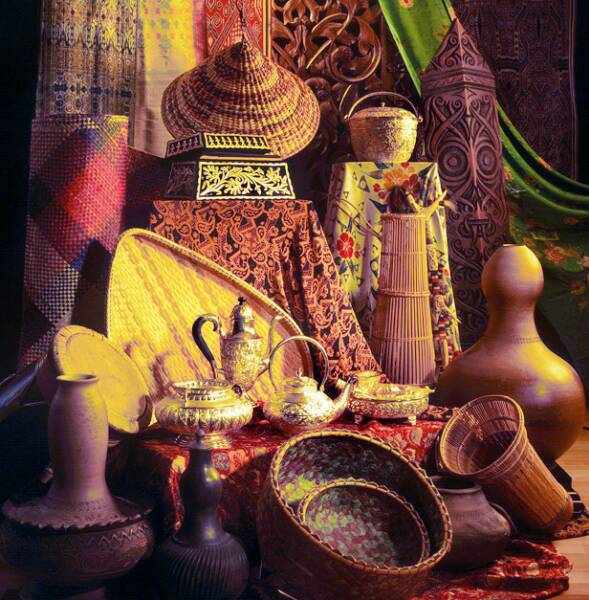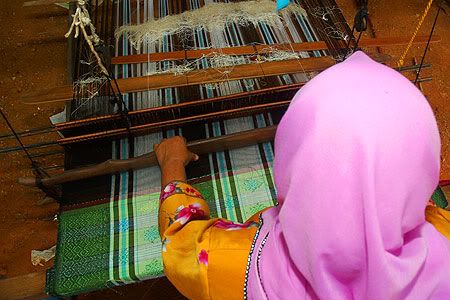"Handicraft Products"
means any product that has artistic or traditional cultural attractions and is
the result of a process that depends solely or partly to the skill of hand and
includes any product batik and "batik product" means any article,
however, produced a batik design on or in any part of it.
Malaysia has a wealth of traditional arts and crafts. Many villagers are skilled artisans, and they dedicate a great deal of time and effort towards creating these exquisite pieces. Handicrafts can be made of fabric, wood, bamboo and many more. They make excellent souvenirs.
Crafts of Malaysia are varied and it reflects the multiculturalism of the country. The major crafts of the country are Batik, Songket, Wood carving, Mengkuang, Kite Making, Keris, Boat Making and Ratan Weaving. Batik features coloured designs on cotton or silk, produced by using wax to the parts of the textile left uncoloured. Songket is a form of craft that descends from the Pattani courts and it is used generally on special occasions. This form of craft is known as the “cloth of gold” and is created by interweaving threads with gold and silver strands. Woodcarving is one of the oldest traditional crafts in the country and is applied in the designs of supports, balustrades, doors, window shutters, and furniture of houses and palaces. Mengkuang previously used to be a leisure activity of the village women of coastal parts of the country but now it has become transformed into a full fledged cottage industry. The craftsmen use the tall thorny leaves of mengkuang to make colourful mats, beach bags, hats, fans, purses, and slippers. Kite making is also a part of the traditional crafts of the country along with boat making, keris and rattan weaving.
Earthenware / Pottery
Popular items of traditional design include Perak's labu sayong, geluk, belanga, Chinese dragon kiln ceramics and Sarawakian tribal motive pottery. Sarawak pottery is known throughout the region. Boasting intricate designs and traditional craftsmanship, Sarawak pottery has a distinctand exotic look. Contemporary items include vases, flower pots, decorative pottery, sculpture and kitchenware.
Labu Sayong is a black-coloured gourd-shaped clay jar typically used to store and cool water. The state of Perak is renowned for this type of pottery. Perak is known for its labu sayong, a distinctly shaped clay vessel. It is traditionally used as a water receptacle. The water that has been stored in a labu sayong is said to be very cool and greatly refreshing.
Wood Crafts
Blessed with an abundance of timber in boundless tropical forests, Malaysia is renowned for an assortment of distinctive wood crafts. Traditionally, whole houses were built from elaborate hand-carved timber. Today, antique Malay-styled engraved panels, keris dagger handles, Chinese containers, unique Orang Asli spirit sculptures, intricate walking sticks, kitchen utensils and carved scented woods are among the wide range of exotic decorative items found in Malaysia.
Metal Crafts
Popular since the early days, traditional brass casting and bronze working are still used to make an array of utensils. More recently in the 19th century, with the discovery of tin in Malaysia, pewter has become increasingly popular. Metal craft products include modern decorative items, kitchen ware and traditional artifacts like tepak sireh sets, rose-water instruments and keris blades. Copper was the first metal used by humans. In Malaysia, the use of copper is believed to start from the pre-historic period.
Textiles
Colourful and captivating, Malaysia's traditional textiles are much sought after worldwide. Varieties include batik, songket, pua kumbu and tekat. These textiles are made into all sorts of decorative items, from haute couture clothes to shoes, colourful curtains and delicate bed linen. Batik
Referring to the process of dyeing fabric by making use of a resistant technique; covering areas of cloth with wax to prevent it absorbing colours. The colours in batik are much more resistant to wear than those of painted or printed fabrics because the cloth is completely immersed in dye. The batik is hand-drawn in intricate details duplicating local floral motifs, a practice that calls for skill, patience, flair and creativity.
Songket
Utilising an intricate supplementary weft technique where gold threads are woven in between the longitudinal silk threads of the background cloth. In the past, this rich and luxurious fabric demonstrated the social status of the Malay elite.






Your work is really influential. Your information in this blog is very helpful for every visitor of this page. Thank you very much for share such a great information with us.
ReplyDeleteWindow Blinds